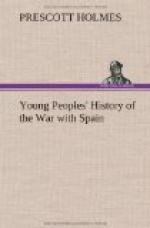Before the marines were reinforced they were fighting nearly all the time. It was the first time that most of them had been in battle, but they fought like veterans. The Spaniards were very cunning and constantly planned surprises for them, but the marines finally drove them away and held their position until reinforcements came. One of the marines, in writing home, said:
“They fight Indian fashion, and the guerillas strip off all their clothing and dress themselves with leaves and crawl along the ground like snakes, and at night it is very hard to see or hear them. Then, again, they dig holes in the ground and cover them over with brush and conceal themselves there until their prey comes along. Their signals are very hard to understand, and they sound like birds and are very deceiving.
[Illustration: A Spanish Guerilla.]
“We have to carry our rifles and ammunition with us wherever we go. Yesterday morning, while we were eating our breakfast, they fired upon us, and we immediately pursued them. We had quite a battle and came out victorious by a big score. We killed sixty and left about fifteen or twenty badly wounded. We had a lucky escape, only two men being wounded. We stayed out all night, and were relieved by another company this morning, and we had nothing to eat for forty-eight hours; but this is not the first time that we have missed our meals—it is an every-day occurrence. We had four hardtacks, a little piece of butter and a cup of coffee.
“We were reinforced by sixty Cuban insurgents last night. They were fitted out with uniforms and rifles by the Marblehead, and they all carry that deadly-looking weapon, the machete.”
The machete is the national weapon of Cuba. It looks somewhat like a sword, but instead of being pointed like that weapon, it is broader at the part farthest from the hilt. A strong man can strike a terrible blow with it. It is used all over the island as an agricultural tool as well, for it serves the purpose of a scythe or an axe.
[Illustration: In the Trenches at Guantanamo.]
A brave deed was done by a young officer of the Navy all by himself—a deed as brave as that done by Lieutenant Hobson. It was not really known how many Spanish ships were in the harbor of Santiago. I have told you that they could not be seen by our ships on account of the narrow entrance and high cliffs. It was very important to know how many Spanish ships there were. So Lieutenant Blue went ashore at some safe point, and climbed round the hilltops of Santiago at night, looked at the harbor, and counted the ships twice, in order to make no mistake. It was a long journey and full of danger. Lieutenant Blue might have been taken as a spy, but he reached our ships again, and made his report to Admiral Sampson.
Early in June our blockading ships made efforts to destroy the forts at the harbor of Santiago, but did not succeed, though the shells from our ships did a good deal of harm. It was on account of these attacks that Lieutenant Hobson and his crew were removed from their cells in Morro Castle and taken to another prison, as I have told you. The English Consul at Santiago, a wise and good man, told the Spanish general that Lieutenant Hobson and his men could not, in honor, be kept where they might be killed by shells from their own ships. So the prisoners were removed.




